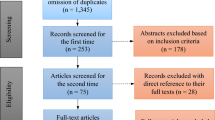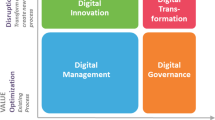Abstract
The use of digital badges is a trend in today’s education and professional settings. We conducted an exploration to see how badges are being used in higher education. Digital badges and more specifically, open badges, are used in a multitude of learning contexts and serve many purposes. This study conducted interviews with individuals leading digital badge initiatives in higher education institutions. Our findings suggest that badges awarded for participation are valued less meaningful than skill-based badges. For skill-based badges, evidence of mastery must be associated with the badge along with the evaluation criteria. Badge purpose, transferability, and learning objectives were noted as the top priorities when implementing badge offerings in higher education contexts.
Similar content being viewed by others
References
Abramovich, S. (2016). Understanding digital badges in higher education through assessment. On the Horizon, 24(1), 126–131.
Abramovich, S., Schunn, C., & Higashi, R. (2013). Are badges useful in education? It depends upon the type of badge and expertise of learner. Educational Technology Research and Development, 61(2), 217–232. https://doi.org/10.1007/s11423-013-9289-2.
Abramovich, S., & Wardrip, P. (2016). Impact of badges on motivation to learn. In L. Y. Muilenburg & Z. L. Berge (Eds.), Digital badges in education: Trends, issues, and cases (pp. 53–61). New York: Routledge.
Ahn, J., Pellicone, A., & Butler, B. S. (2014). Open badges for education: What are the implications at the intersection of open systems and badging? Research in Learning Technology, 22(1), 1–13.
Ash, K. (2012a). Digital badges would represent students’ skill acquisition. Education Week, 5(3), 24–25.
Ash, K. (2012b). Colleges use ‘digital badges’ to replace traditional grading. Education Week, 5(3), 26–27.
Carey, K. (2012). A future full of badges. Chronicle of Higher Education, 58(32), 60.
Catalano, F., & Doucet, K. J. (2013). Digital ‘badges’ emerge as part of credentialing’s future. Retrieved September 20, 2017, from http://www.proexam.org/images/resources/ProExam_DigitalBadgesPaper_071713.pdf
Coffey, A., & Atkinson, P. (1996). Making sense of qualitative data: Complementary research strategies. Thousand Oaks, CA: Sage.
Creswell, J. (2015). Educational research: Planning, conducting, and evaluating quantitative and qualitative research (5th ed.). New York: Pearson.
Cucchiarra, S., Giglio, A., Persico, D., & Raffagheli, J. E. (2014). Supporting self-regulated learning through digital badges: A case study. In Y. Cao, et al. (Eds.), International conference on web-based learning (pp. 133–142). New York: Springer.
Deci, E. L. (1971). Effects of externally mediated rewards on intrinsic motivation. Journal of Personality and Social Psychology, 18, 105–115.
Deci, E. L., Koestner, R., & Ryan, R. M. (2001). Extrinsic rewards and intrinsic motivation in education: Reconsidered once again. Review of Educational Research, 71(1), 1–27.
Devedžić, V., & Jovanović, J. (2015). Developing open badges: A comprehensive approach. Educational Technology Research and Development, 63(4), 603–620.
Dickey, M. (2005). Engaging by design: How engagement strategies in popular computer and video games can inform instructional design. Educational Technology Research and Development, 53(2), 67–83.
Dodd, T. (2014). Digital badge sets students on new course. Financial Review. Retrieved August 10, 2017, from http://www.afr.com/p/national/education/digital_badge_sets_students_on_new_1iN8Ytv03Y8yAfBuHxVEQM
Dyjur, P., & Lindstrom, G. (2017). Perceptions and uses of digital badges for professional learning development in higher education. Tech Trends, 61(4), 386–392.
Elliot, A. J. (1999). Approach and avoidance motivation and achievement goals. Educational Psychologist, 34(3), 169–189.
Elliott, R., Clayton, J., & Iwata, J. (2014). Exploring the use of microcredentialing and digital badges in learning environments to encourage motivation to learn and achieve. In B. Hegarty, J. McDonald, & S. K. Loke (Eds.), Rhetoric and reality: Critical perspectives on educational technology (pp. 703–707). Dunedin, New Zealand: Australasian Society for Computers in Learning in Tertiary Education.
Fanfarelli, J. R., & McDaniel, R. (2015). Individual differences in digital badging: Do learner characteristics matter? Journal of Educational Technology Systems, 43(4), 403–428.
Fields, E. (2015). Making visible new learning: Professional development with open digital badge pathways. Partnership, 10(1), 1–10.
Finkelstein, J., Knight, E., & Manning, S. (2013). The potential and value of using badges for adult learners. Washington, DC: American Institute for Research.
Gamrat, C., Bixler, B., & Raish, V. (2016). Instructional design considerations for digital badges. In L. Y. Muilenburg & Z. L. Berge (Eds.), Digital badges in education: Trends, issues, and cases (pp. 71–81). New York: Routledge.
Gamrat, C., Zimmerman, H. T., Dudek, J., & Peck, K. (2014). Personalized workplace learning: An exploratory study on digital badging within a teacher professional development program. British Journal of Educational Technology, 45(6), 1136–1148. https://doi.org/10.1111/bjet.12200.
Gibson, D., Ostashewski, N., Flintoff, K., Grant, S., & Knight, E. (2015). Digital badges in education. Education and Information Technologies, 20(2), 403–410.
Giorgi, A. P., & Girogi, B. M. (2003). The descriptive phenomenological psychological method. In P. M. Cami, J. E. Rhodes, & L. Yardley (Eds.), Qualitative research in psychology: Expanding perspectives in methodology and design (pp. 243–273). Washington, DC: American Psychological Association.
Glover, I. & Latif, F. (2013). Investigating perceptions and potential of open badges in formal higher education. In J. Herrington, A. Couros, & V. Irvine (Eds.), Proceedings of world conference on educational multimedia, hypermedia and telecommunications 2013 (pp. 1398–1402).
Goligoski, E. (2012). Motivating the learner: Mozilla’s open badges program. Access to Knowledge: A Course Journal, 4(1)
Grant, S. (2016). History and context of open digital badges. In L. Y. Muilenburg & Z. L. Berge (Eds.), Digital badges in education: Trends, issues, and cases (pp. 3–11). New York: Routledge.
Hakulinen, L., Auvinen, T., & Korhonen, A. (2013). Empirical study on the effect of achievement badges in TRAKLA2 online learning environment. In Proceedings of the 2013 learning and teaching in computing and engineering—LATICE’13 (pp. 47–54). Washington, DC: IEEE Computer Society.
Hays, D. G., & Singh, A. A. (2012). Qualitative inquiry in clinical and educational settings. New York: Guilford.
Hickey, D. T., Otto, N., Itow, R., Schenke, K., Tran, C., & Chow, C. (2014). Badges design principles documentation (DPD). Interim project report. Retrieved from Indiana University, Center for Research on Learning and Technology website http://iudpd.indiana.edu/JanuaryReport
Hickey, D. T., Quick, J. D., & Shen, X. (2015). Formative and summative analyses of disciplinary engagement and learning in a big open online course. Paper presented at the Proceedings of the Fifth International Conference on Learning Analytics and Knowledge, Poughkeepsie, NY.
Hickey, D. T., & Soylu, F. (2012). Wikifolios, reflections, and exams for online engagement, understanding, and achievement. Journal of Teaching and Learning with Technology, 1(1), 64–71.
Hsieh, H. F., & Shannon, S. E. (2005). Three approaches to qualitative content analysis. Qualitative Health Research, 15(9), 1277–1288.
Joseph, B. (2012). Six ways to look at badging systems designed for learning. Retrieved September 15, 2017, from the Online Leadership Program website
Jovanovic, J., & Devedzic, V. (2014). Open badges: Challenges and opportunities. In Proceedings of The 13th international conference on web-based learning-ICWL 2014 (pp. 56–65). Berlin: Springer.
Jovanovic, J., & Devedzic, V. (2015). Open badges: Novel means to motivate, scaffold and recognize learning. Technology, Knowledge and Learning, 20(1), 115–122.
Kondracki, N. L., & Wellman, N. S. (2002). Content analysis: Review of methods and their applications in nutrition education. Journal of Nutrition Education and Behavior, 34, 224–230.
Kwon, K. H., Halavais, A., & Havener, S. (2015). Tweeting badges: User motivations for displaying achievement in publicly networked environments. Cyberpsychology, Behavior, and Social Networking, 18(2), 93–100.
Laanpere, M., Pata, K., Normak, P., & Põldoja, H. (2014). Pedagogy-driven design of digital learning ecosystems. Computer Science and Information Systems, 11(1), 419–442.
Lemoine, P. A., & Richardson, M. D. (2015). Micro-credentials, nano degrees, and digital badges: New credentials for global higher education. International Journal of Technology and Educational Marketing, 5(1), 36–49.
Lincoln, Y. S., & Guba, E. G. (1985). Naturalistic inquiry. Newbury Park, CA: Sage.
Martinez, M. E. (2010). Learning and cognition: The design of the mind. Upper Saddle River, NJ: Pearson.
Mayring, P. (2000). Qualitative content analysis. Forum: Qualitative Social Research, 1(2), 20. Retrieved March 1, 2018, from http://www.qualitative-research.net/fqs-texte/2-00/02-00mayring-e.htm.
McDaniel, R., & Fanfarelli, J. R. (2015). A digital badging dataset focused on performance, engagement and behavior-related variables from observations in web-based university courses. British Journal of Educational Technology. https://doi.org/10.1111/bjet.12272.
O’Byrne, W. I., Schenke, K., Willis, J. E., III, & Hickey, D. T. (2015). Digital badges: Recognizing, assessing, and motivating learners in and out of school contexts. Journal of Adolescent & Adult Literacy, 58(6), 451–454. https://doi.org/10.1002/jaal.381.
O’Connor, E. A., & McQuigge, A. (2013). Exploring badging for peer review, extended learning and evaluation, and reflective/critical feedback within an online graduate course. Journal of Educational Technology Systems, 42(2), 87–105. https://doi.org/10.2190/ET.42.2.b.
Olneck, M. (2012). Insurgent credentials: A challenge to established institutions of higher education. Retrieved August 10, 2017, from HASTAC website http://www.hastac.org/files/insurgent_credentials__michael_olneck_2012.pdf
Ostashewski, N., & Reid, D. (2015). A history and frameworks of digital badges in education. In T. Reiners & L. C. Woods (Eds.), Gamification in Education and Business (pp. 187–200). New York: Springer.
Parker, H. E. (2015). Digital badges to assess bloom’s affective domain. The National Teaching & Learning Forum, 24(4), 9–11. https://doi.org/10.1002/ntlf.30031.
Patton, M. Q. (2002). Qualitative research and evaluation methods. Thousand Oaks, CA: Sage.
Pintrich, P. R., & De Groot, E. V. (1990). Motivational and self-regulated learning components of classroom academic performance. Journal of Educational Psychology, 82(1), 33–40.
Randall, D. L., Harrison, J. B., & West, R. E. (2013). Giving credit where credit is due: Designing open badges for a technology integration course. TechTrends, 57(6), 88–95. https://doi.org/10.1007/s11528-013-0706-5.
Reid, A. J., Paster, D., & Abramovich, S. (2015). Digital badges in undergraduate composition courses: Effects on intrinsic motivation. Journal of Computers in Education, 2(4), 377–398.
Rughinis, R. (2013). Talkative objects in need of interpretation: Re-thinking digital badges in education. In W. E. Mackay, S. Brewster, & S. Bødker (Eds.), CHI ’13 extended abstracts on human factors in computing systems, CHI EA’13 (pp. 2099–2108). New York: ACM.
Schenke, K., Tran, C., & Hickey, D. (2013) Design principles for motivating learning with digital badges. HASTAC. Retrieved August 14, 2017, from http://www.hastac.org/blogs/kschenke/2013/06/05/design-principles-motivating-learning-digital-badges
Schunk, D. H. (1991). Self-efficacy and academic motivation. Educational Psychologist, 26(3 & 4), 207–231.
Shen, C. (2014). Announcing nanodegrees: A new type of credential for a modern workforce. Retrieved January 16, 2018, from: https://blog.udacity.com/2014/06/announcing-nanodegrees-new-type-of.html
Shunck, D. H. (1990). Goal setting and self-efficacy during self-regulated learning. Educational Psychologist, 25(1), 71–86.
Spradley, J. P. (1979). The ethnographic interview. New York: Holt, Rinehart, & Winston.
Tally, S. (2012, September 11). Digital badges show students’ skills along with degree. Purdue News. Retrieved September 1, 2017, from http://www.purdue.edu/newsroom/releases/2012/Q3/digital-badges-show-students-skills-along-with-degree.html
West, R. E., & Randall, D. L. (2016). The case for rigor in open badges. In L. Y. Muilenburg & Z. L. Berge (Eds.), Digital badges in education: Trends, issues, and cases (pp. 21–29). New York: Routledge.
Wilson, B. G., Gasell, C., Ozyer, A., & Scrogan, L. (2016). Adopting digital badges in higher education: Scoping the territory. In D. Ifenthaler, N. Bellin-Mularski, & D.-K. Mah (Eds.), Foundation of digital badges and micro-credentials (pp. 163–177). Switzerland: Springer.
Zimmerman, B. (1990). Self-regulated learning and academic achievement: An overview. Educational Psychologist, 25(1), 3–17.
Author information
Authors and Affiliations
Corresponding author
Ethics declarations
Conflict of interest
The authors declare that they have no conflict of interest.
Rights and permissions
About this article
Cite this article
Carey, K.L., Stefaniak, J.E. An exploration of the utility of digital badging in higher education settings. Education Tech Research Dev 66, 1211–1229 (2018). https://doi.org/10.1007/s11423-018-9602-1
Published:
Issue Date:
DOI: https://doi.org/10.1007/s11423-018-9602-1




